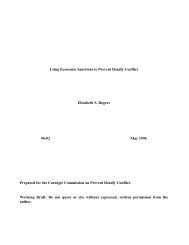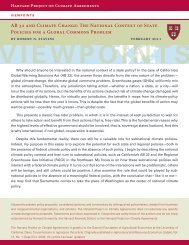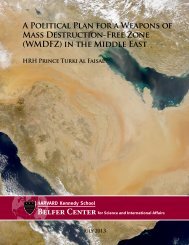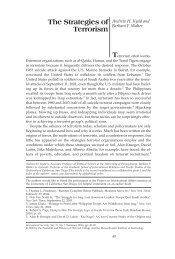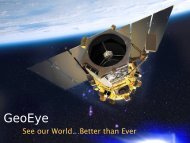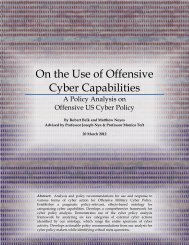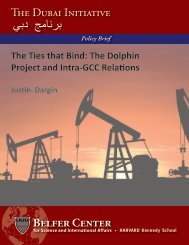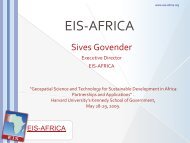Plutonium Mountain - Belfer Center for Science and International ...
Plutonium Mountain - Belfer Center for Science and International ...
Plutonium Mountain - Belfer Center for Science and International ...
- No tags were found...
You also want an ePaper? Increase the reach of your titles
YUMPU automatically turns print PDFs into web optimized ePapers that Google loves.
The Small Experiments<br />
The United States began a voluntary suspension of nuclear weapons tests on October 31, 1958.<br />
The Soviet Union joined after two tests in November. On December 29, 1959, President Eisenhower<br />
said that he would honor the suspension, but the United States would continue to carry<br />
out research <strong>and</strong> development, including “laboratory-type experiments.” At the time, the United<br />
States was headed toward building smaller, lighter nuclear warheads that would fit atop ballistic<br />
missiles. These <strong>and</strong> other weapons required safety testing to make sure they would not produce a<br />
fission explosion if an accident resulted in detonation of the chemical high explosives used in the<br />
weapon.<br />
This gave rise to “hydronuclear” experiments, which involved using high explosives to crush fissile<br />
material, such as plutonium or HEU, without setting off a significant nuclear blast. It was realized<br />
that by reducing the amount of fissile material, the yield could be kept very low, much less<br />
than what most people envision when they think of a nuclear explosion. Such experiments are<br />
sometimes called “zero-yield” tests, but the energy released by fission, while small, is not necessarily<br />
zero. The United States began conducting hydronuclear tests on January 12, 1960. 15<br />
In the United States, the tests were aimed at achieving a safety st<strong>and</strong>ard known as one-point safe.<br />
This was defined as the assurance that in the event of a detonation at any single point of the highexplosive<br />
system of a nuclear weapon, the chance of a nuclear energy release in excess of four<br />
pounds equivalent of TNT would be less than one in a million. The first U.S. hydronuclear experiments<br />
were carried out in a deep hole at Technical Area 49 on the grounds of the Los Alamos<br />
National Laboratory in New Mexico; subsequent work was also per<strong>for</strong>med at the Nevada Test<br />
Site, primarily by the Lawrence Livermore National Laboratory. 16<br />
The Soviet Union began its hydronuclear tests at the Semipalatinsk site in Kazakhstan in 1958,<br />
<strong>and</strong> over the next 32 years, the Soviets fired off 85 hydronuclear devices at three separate locations.<br />
While the Semipalatinsk site was closed <strong>and</strong> considered secret, the Soviet activities were<br />
observed by U.S. intelligence satellites. For a number of years, the satellite photos showed a<br />
htmlsq=kazakhstan&st=cse&adxnnl=1&scp=4&pagewanted=all&adxnnlx=1358883389-3cLkFKRLYih964BQBu0HqA&_r=0<br />
(accessed July 28, 2013).<br />
15<br />
Robert N. Thorn <strong>and</strong> Donald R. Westervelt, “Hydronuclear Experiments,” Los Alamos National Laboratory, LA-10902-<br />
MS, February, 1987. Thorn <strong>and</strong> Westevelt note that the value of these tests was demonstrated in the 1966 accident when a B-52<br />
bomber with nuclear weapons aboard collided in midair with a KC-135 tanker near the fishing village of Palomares, Spain. In one<br />
of the nuclear weapons that fell to the ground, the high explosive detonated, but there was not a fission explosion due to the safety<br />
measures that had been introduced.<br />
Along with hydronuclear tests, certain safety <strong>and</strong> reliability tests—termed “studies of accidental modes” in U.S. testing parlance—were<br />
designed to ensure that the material did not fission at all. In the early days of the Cold War, such tests were quite<br />
crude: British scientists set nuclear weapons on fire in the Australian desert, according to John Carlson, the <strong>for</strong>mer director<br />
general of the Australian Safeguards <strong>and</strong> Nonproliferation Office. Carlson spoke to the authors in a September 2012 interview.<br />
More sophisticated experiments could potentially leave behind equally dangerous materials. So-called “popcorn tests,” <strong>for</strong> instance,<br />
were designed to test whether a nuclear warhead will detonate unintentionally if a conventional explosion occurs nearby.<br />
“One-point safety” experiments test whether a weapons’ physics package (i.e. plutonium <strong>and</strong> other elements that fuel a nuclear<br />
bomb) will ignite if only one section of the multiple conventional explosives arranged around it pre-detonated. These experiments<br />
involved a significant quantity of weapon-grade plutonium which was not dispersed by a large explosion <strong>and</strong> could potentially be<br />
recovered <strong>and</strong> used to make a bomb.<br />
16<br />
Thomas C. Reed <strong>and</strong> Danny B. Stillman, The Nuclear Express: A Political History of the Bomb <strong>and</strong> Its Proliferation, (Minneapolis:<br />
Zenith Press, 2009) pp. 62-63.<br />
6<br />
<strong>Plutonium</strong> <strong>Mountain</strong>: Inside the 17-year mission to secure a dangerous legacy of Soviet nuclear testing



